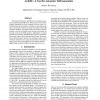37 search results - page 7 / 8 » Application-independent evaluation of speaker detection |
ACSW
2004
13 years 6 months ago
2004
This paper describes an approach to the detection of stress in spoken New Zealand English. After identifying the vowel segments of the speech signal, the approach extracts two dif...
ICASSP
2010
IEEE
13 years 3 months ago
2010
IEEE
In this paper we address the problem of estimating who is speaking from automatically extracted low resolution visual cues in group meetings. Traditionally, the task of speech/non...
ICASSP
2011
IEEE
12 years 9 months ago
2011
IEEE
The focus of the 2010 NIST Speaker Recognition Evaluation (SRE) [1] was the low false alarm regime of the detection error trade-off (DET) curve. This paper presents several approa...
INTERSPEECH
2010
13 years 5 days ago
2010
This paper describes the AuToBI tool for automatic generation of hypothesized ToBI labels. While research on automatic prosodic annotation has been conducted for many years, AuToB...
ICASSP
2008
IEEE
13 years 11 months ago
2008
IEEE
The reverberation time is one of the most prominent acoustic characteristics of an enclosure. Its value can be used to predict speech intelligibility, and is used by speech enhanc...

